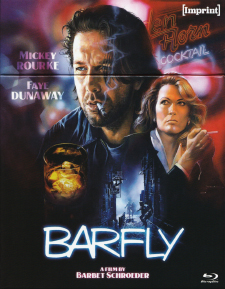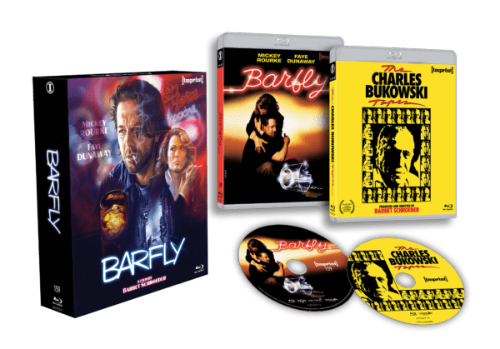Barfly: Limited Collector’s Edition (Blu-ray Review)

Director
Barbet SchroederRelease Date(s)
1987 (October 7, 2022)Studio(s)
American Zoetrope/Cannon Films (Imprint Films/Via Vision Entertainment)- Film/Program Grade: B
- Video Grade: A
- Audio Grade: A
- Extras Grade: A+
Review
[Editor's Note: This is a Region Free Blu-ray release.]
Charles Bukowski was a Los Angeles drifter who devoted his life to hanging out in skid row bars and flophouses until the age of 50. He was also a prolific writer of poetry, short stories, and novels. Barfly, based on his original screenplay, is a drama with touches of humor that portrays a seamy, pointless lifestyle yet manages to fascinate.
Henry Chinaski (Mickey Rourke), Bukowski’s alter-ego, is a slovenly, hard-drinking loser who hangs out at the Golden Horn bar and has a penchant for getting into fistfights with bartender Eddie (Frank Stallone) and is regularly beaten to a pulp. The film begins with one of their brutal, bloody fights in the alley outside the bar. This appears to be an almost daily occurrence in Henry’s life, along with drinking and occasionally writing poetry that reflects his skid row existence.
One day, Henry spots another barfly sitting at the end of the bar. Her name is Wanda Wilcox (Faye Dunaway), who wears a rumpled business suit, and easily matches Henry’s affection for the bottle. They strike up a conversation, see in each other a kindred spirit, and Henry accepts her invitation to move in with her despite her clear signs of instability, both mental and emotional.
Henry gets the chance to rise from his abyss of aimlessness when a wealthy publisher, classy and sophisticated Tully Sorenson (Alice Krige), offers him a commission for his writings. The polar opposite of Wanda, Tully falls for Henry, who has a romance with her that leads to a confrontation when Wanda finds out about it.
Rourke immerses himself in the role of Henry. Looking constantly under the influence of booze, in disheveled attire often stained with dried blood, moving slowly as if carefully monitoring every step so he won’t collapse, Rourke creates an authentic portrayal of a man who, rather than be depressed, has embraced his lifestyle and enjoys the constant haze that alcohol provides him. The new women in his life challenge him to aspire to a better self. There are moments when we get to see something deeper in Henry, and that’s what keeps us rooting for him. Touches of humor that Rourke infuses throughout the film help his character to become relatable and seem capable of at least a little redemption. Tully’s recognition of Henry’s literary talent wakes him up to brighter possibilities, but his marriage to the bottle is a tough obstacle to overcome.
Faye Dunaway plays Wanda with greasy hair and no make-up in a completely de-glamorized role. Though her natural beauty is there, it belongs not to a movie star, but to a woman whose drinking has taken its toll. Wanda is a call-girl who, like Henry, spends her days drinking away her pain. Dunaway’s screen chemistry with Rourke is excellent, even though their characters are not your customary leading man and woman. Dunaway is up to the demands of the role, whether looking haggard, running barefoot up a hill, stealing ears of corn, or engaging in a believable bar fight with romantic rival Tully. As Wanda remarks at one point, “We’re all in some kind of hell.”
Director Barbet Schroeder (Single White Female) has created a spirited romance of the lower depths. He balances the film so that it never becomes irrevocably grim and despondent. Henry maintains his cool as he comes out with semi-philosophical one-liners to various characters. As a poet of society’s lower echelons, he’s developed street cred and respect from his limited circle of acquaintances. Schroeder has chosen dingy locations, effectively establishing the world of the barfly and illustrating a lifestyle that’s not usually seen in such detail.
Though the actors do a fine job inhabiting their roles, the film distances us from them rather than drawing us in. It’s as if we’re looking at museum exhibits. Composed of episodes instead of a straight narrative flow, the structure of the film replicates the loose living of the barfly. Certain scenes seem almost documentary-like in their grittiness, yet Henry and Wanda fulfill many stereotypes of the alcoholic. It’s only Henry’s artistic flair that defies the stereotype.
Barfly was shot by director of photography Robby Muller with on 35 mm film with spherical lenses, finished photochemically, and presented in the aspect ratio of 1.85:1. The Imprint Films Blu-ray release is sourced from the same master that Koch Media worked with in 2011. It’s an older master that comes from MGM’s vaults. There are no visible imperfections to hamper it as it appears quite clean. Clarity and detail are very good. Many scenes are shot at night or in dim bars. The main location—the Golden Horn bar—is bathed in yellow light from overhead bulbs, giving complexions a yellowish cast. There are few bright primary hues. Clothing worn by Henry, Wanda, and the bar regulars tends toward darker colors. Tully’s neat, tailored suit is grey, representing her affluence and style. A blinking red neon Flying A advertisement is seen outside Henry’s dingy apartment window. Apartment sets are spare, with stained bare walls, a dirty mattress without sheets, and undraped windows.
The soundtrack is English 2.0 LPCM. English SDH subtitles are an available option. Clarity is excellent and dialogue is clear throughout. Rourke speaks slowly and deliberately, suggesting constant haziness from booze. Ambient bar chatter is heard under the dialogue. Stallone’s Eddie speaks to Henry with impatient contempt. The sound is sweetened in the two major alley fights between Eddie and Henry. Sounds of fists hitting faces, bodies being pummeled, grunts, and bodies falling into garbage pails contribute to the staged fights’ believability. There’s no traditional score and everything is made up of source music.
Bonus material on this 2-Disc Region Free Blu-ray release includes the following on the first disc, which contains the film itself:
- Audio Commentary with Barbet Schroeder
- Audio Commentary with Kim Cooper and Richard Schave
- High Society (19:42)
- Another Round (13:41)
- To All My Friends (9:33)
- Low Life and Dive Bars (13:32)
- I Drink, I Gamble, I Write: The Making of Barfly (12:02)
- Theatrical Trailer (2:01)
Audio Commentary #1 – Director Barbet Schroeder discusses scouting several Los Angeles area bars and finally settling on the Golden Horn because it had a rounded bar that would work well for blocking dialogue scenes. The fights reflected those that often occurred in reality. Frank Stallone had a mustache to minimize his similarity in appearance to his brother, Sylvester Stallone. Schroeder’s first meeting with Charles Bukowski went very well and Bukowski came to realize that writing for the screen had to be more economical than for a novel. Schroeder discusses the film’s authentic locations. At one point, Cannon Films was going to shelve the film. Schroeder tried desperately to find another investor and failed until Cannon eventually agreed to make the film. Schroeder talks about the performances of Mickey Rourke and Faye Dunaway.
Audio Commentary #2 – Kim Cooper and Richard Schave run a tour business in Los Angeles called Esoteric Tours and speak at length and in great detail about the locations used in the film. Many of the locations have been demolished, others are under new management, still others transformed for other businesses. The changing neighborhoods are the result of development and gentrification, which displaced longtime residents. The film reflects the lifestyle of Charles Bukowski. The commentators compare written versions of the script to what appears on screen. The film is about “Bukowski coming out of his cocoon.”
High Society – Alice Krige speaks about her character, Tully, “sweeping in and saving” Henry. She speaks about the careers of her parents and her own career. She originally intended to become a clinical psychologist. She had a role in a small film in her native country of South Africa, took classes in theater and stage management, and eventually made her way into feature films.
Another Road – Frank Stallone discusses his character as “not a nice guy”—a bully and a braggart. He appeared on stage before he started in films and admits that he was turned down a lot at auditions. In Staying Alive, he learned the film business. Better film roles followed. Rourke stood up for Stallone when the producers wanted to replace him. Stallone refers to Rourke as an original. Schroeder didn’t want Faye Dunaway to wear any make-up. The Golden Horn was a neighborhood bar in Culver City, California. Stallone discusses the staging of the alley fights, noting that the “brick wall” was actually made of rubber. “Eddie,” he notes, “is a poor version of Scarface’s Tony Montana.”
To All My Friends – Editor Eva Gardos says the pacing reveals itself based on the dailies. Gardos was a production assistant on Apocalypse Now and worked with directors Peter Bogdanovich, Hal Ashby, and Martha Coolidge. Schroeder thought many of her ideas were good and used them. It was important to balance humor with drama without undermining either or both. The film was received well at the Cannes Film Festival. The director was passionate about Barfly and spent a long time putting the project together.
Low Lifes and Dive Bars – Production designer Bob Ziembicki majored in photography and film and started his career working for Roger Corman. Barbet Schroeder threatened the producers that he would cut off his little finger if he didn’t get to make the film. He insisted that the sets look believable and didn’t want extraneous set dressing. He wanted lots of neon, particularly the red Flying A logo. Wanda’s apartment was scaled down in size. Schroeder was initially leery about hiring Mickey Rourke. He wanted Sean Penn for the role of Henry. Ziembicki acknowledges cinematographer Robby Muller with teaching him a lot about the relationship between photography and set design.
I Drink, I Gamble, I Write – In this making-of featurette, Charles Bukowski talks about his own experience as a barfly. Director Barbet Schroeder talked him into writing the screenplay, which shows a dark side of America that’s seldom seen in movies. “Mickey [Rourke] has brought his own inventiveness to the role,” Rourke notes about Henry. “He’s dead inside. He just exists.” In nearly every shot, Bukowski is either drinking or holding a beer. He philosophically notes, “Success can make an asshole out of anyone.”
The second disc contains the documentary The Bukowski Tapes, a four and a half hour collection of interviews with the screenwriter and subject for the story by Barbet Schroeder. The film is presented in the aspect ratio of 1.33:1 and features an English 2.0 mono LPCM soundtrack.
Barfly puts the spotlight on the often invisible people of society who have isolated themselves in small communities drawn together by alcohol. Henry and Wanda are unlikely protagonists, though they’re colorful and often manage to find humor in their drab, hopeless lives. Barbet Schroeder takes a close look at these people without condemning them. The film is not a public service message about the dangers of booze but a cold, unadulterated portrait of a dissipated lifestyle.
- Dennis Seuling


